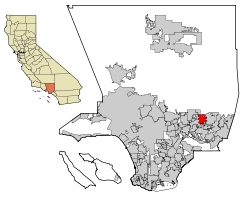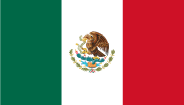Azusa, California
| City of Azusa | |
|---|---|
| — City — | |
 |
|
| Coordinates: | |
| Country | United States |
| State | California |
| County | Los Angeles |
| Incorporated (city) | December 29, 1898 |
| Area | |
| - Total | 8.9 sq mi (23.1 km2) |
| - Land | 8.9 sq mi (23.1 km2) |
| - Water | 0.0 sq mi (0.0 km2) 0% |
| Elevation | 610 ft (186 m) |
| Population | |
| - Total | 44,712 |
| - Density | 5,023.7/sq mi (1,939.7/km2) |
| Time zone | PST (UTC-8) |
| - Summer (DST) | PDT (UTC-7) |
| ZIP code | 91702 |
| Area code(s) | 626 |
| FIPS code | 06-03386 |
| GNIS feature ID | 1652667 |
| Website | http://www.ci.azusa.ca.us/ |
Azusa is a city in Los Angeles County, California, United States. The population was 44,712 at the 2000 census. Though sometimes assumed to be a compaction of the phrase "everything from A to Z in the USA" from an old Jack Benny joke, the place name "Azusa" traces back to at least the eighteenth century. Azusa originally referred to the San Gabriel Valley and river, and likely derives from the Tongva place name Asuksagna.[1]
Contents |
Geography
The City is located at the entrance to the San Gabriel Canyon (hence the city's nickname, The Canyon City) and on the east side of the San Gabriel River.
Azusa is located at (34.130657, -117.906869).[2]
According to the United States Census Bureau, the city has a total area of 23.1 km² (8.9 mi²), all land.
Demographics
As of the census[3] of 2000, there were 44,712 people, 12,549 households, and 9,298 families residing in the city. The population density was 1,939.7/km² (5,023.7/mi²). There were 13,013 housing units at an average density of 564.5/km² (1,462.1/mi²). The racial makeup of the city was 52.35% White, 3.78% Black or African American, 1.31% Native American, 6.14% Asian, 0.17% Pacific Islander, 30.52% from other races, and 5.73% from two or more races. 63.79% of the population were Hispanic or Latino of any race.
There were 12,549 households out of which 43.5% had children under the age of 18 living with them, 49.7% were married couples living together, 17.1% had a female householder with no husband present, and 25.9% were non-families. 18.7% of all households were made up of individuals and 6.2% had someone living alone who was 65 years of age or older. The average household size was 3.41 and the average family size was 3.90.
In the city the population was spread out with 30.8% under the age of 18, 15.5% from 18 to 24, 31.5% from 25 to 44, 15.3% from 45 to 64, and 6.9% who were 65 years of age or older. The median age was 27 years. For every 100 females there were 97.5 males. For every 100 females age 18 and over, there were 93.6 males.
The median income for a household in the city was $39,191, and the median income for a family was $40,918. Males had a median income of $30,845 versus $26,565 for females. The per capita income for the city was $13,412. About 15.1% of families and 18.8% of the population were below the poverty line, including 23.9% of those under age 18 and 10.4% of those age 65 or over.
Government and infrastructure
In the state legislature Azusa is located in the 24th Senate District, represented by Democrat Gloria Romero, and in the 57th Assembly District, represented by Democrat Edward P. Hernandez. Federally, Azusa is located in California's 32nd congressional district, which has a Cook PVI of D +17[4] and is represented by Democrat Judy Chu. The mayor is Joseph Romero Rocha, who has been in the city council. He is married to Linda Rocha.
The Los Angeles County Department of Health Services operates the Monrovia Health Center in Monrovia, serving Azusa.[5]
Education
Azusa is home to Azusa Pacific University, a private Christian university and Dhammakaya Open University, a private Buddhist university.
Azusa is home to St. Frances of Rome Elementary School, serving grades k-8, which is part of St. Frances of Rome Catholic Church, under the Los Angeles Archdiocese.
Azusa is served by the Azusa Unified School District. Its schools include:
- Azusa High School
- Gladstone High School
- Sierra (Continuation) High School A model continuation school
- Azusa Adult School
- Eleven traditional elementary schools - Dalton, Ellington, Gladstone Street, Hodge, Lee, Magnolia, Mountain View, Murray, Paramount, Powell, and Valleydale
- Three intermediate schools - Center, Foothill, and Slauson
- One Kindergarten-only elementary school - Longfellow
- One elementary-intermediate combo school (grades K-8) to be constructed by approximately 2010
Transport
Azusa lies mostly along the Foothill Freeway (I-210) between the San Gabriel River Freeway (I-605) and the Orange Freeway (State Route 57).
Azusa is to be the eastern terminus of the first phase of a planned extension, the "Foothill Extension," of the Metro Gold Line light rail service, which currently operates between Los Angeles Union Station and eastern Pasadena. Like the current Gold Line, it would operate along former Atchison, Topeka & Santa Fe Railway right-of-way purchased by the Metropolitan Transportation Authority in 1993. MTA plans to extend the line to the end of its reserved right-of-way in Montclair, just across the San Bernardino County line.
In October 2009, the MTA Board unanimously voted to include the Foothill Extension in its long-range plan, and approved funding for the construction and operation of the Foothill Extension's first phase to Azusa. The terminus of this extension will be at the second of two stops in Azusa. The first stop will be the Alamada Station, just west of Alameda Avenue and east of Azusa Avenue, a main thoroughfare. The second stop will be at the planned northern extension of Citrus Avenue at Azusa's eastern border. This phase of the extension is scheduled to break ground in June 2010, and is expected to be completed and opened in 2013.
A popular running gag on the long-running radio comedy The Jack Benny Program involved a railroad station announcer, voiced by Mel Blanc, announcing the arrival or departure of a train to or from "Anaheim, Azusa, and Cuc-a-monga." In Benny's day, the Santa Fe offered passenger service through Azusa and Cucamonga. Currently, there is no passenger rail service to Azusa proper, though Metrolink's well-maintained San Bernardino Line stops in nearby Covina and Baldwin Park many times daily. That line also serves Cucamonga, and a change of trains in San Bernardino or Los Angeles will enable one to reach Anaheim.
Public safety
The City of Azusa has its own Police Department, and maintained its own fire department until 1982. The city fire department merged with Los Angeles County Fire Department after a city election where the citizens approved an advisory measure to merge the fire department with the County in order to obtain paramedic and EMT services for the city. The LA County Consolidated Fire Department services Azusa from Fire Station 32 (605 N Alameda) and Fire Station 97 (Sierra Madre Blvd along the foothills), with backup assistance from Fire Station 152, 153, and 154 (Covina), Fire Station 29 (Baldwin Park), Station 44 (Duarte), and Station 48 (Irwindale). Fire Station 32, which was Azusa's own fire station, houses 1 front line paramedic squad with an average of 12.29 calls per 24 hour shift, and 1 front line engine with an average of 7.05 calls per 24 hour shift. Fire Station 32 also houses a reserve engine (E-532), a urban search and rescue trailer, and MA-32. Fire Station 97 houses 1 front line engine, and 1 front line patrol. Fire Station 32 is also home to Explorer Post 16, a youth program for 15-21 year olds that are interested in a career in the fire service. The Post meets on the 1st and 3rd Saturday of every month. The program is a joint with the Boy Scouts of America. Once becoming certified, the Explorer is then allowed to "Ride-Along," with different fire stations throughout the county.
Sister cities
Azusa has one sister city:[6]
 Zacatecas, Mexico
Zacatecas, Mexico
Miscellaneous
The Azusa Police Department was home to the very first Chevrolet Camaro police car ever built. Originally produced at the now-closed GM Assembly Plant in Van Nuys (with a custom turbocharging system donated by race-car legend Gale Banks), it inspired the California Highway Patrol and the Michigan State Police to order a few Camaro police specials for their fleets (with many other police and sheriff's departments as well as the Royal Canadian Mounted Police to follow). The Camaro was finally retired from active service in 2000. At that time it was the only Camaro police car of the original mid-1980s design to remain in service in any California police force.
Azusa was once home to the now defunct Lucky Lager brewery. Built in 1949, the facility was purchased by Miller Brewery in the early 1970s. A decade later, Miller relocated its operations to the nearby city of Irwindale, and the Azusa facility was eventually torn down.
Azusa was also home to a plant for rocket developer, Aerojet. In 1980, it was announced that there was TCE contamination in the groundwater at Aerojet's facility in Azusa in a hearing chaired by State Senator Esteben Torres. In 1985, it was declared a Superfund Site by the EPA as San Gabriel Superfund Site II and the cleanup done under the Baldwin Park Operable Unit. In 1997, it was also discovered that there was also NDMA and Ammonium Perchlorate contamination in this plume and that Aerojet was once again labeled a Potentially Responsible Party in this action. Aerojet sold this facility in 2001 to Northrop Grumman Corporation.
Professional sports teams
| Club | Sport | Founded | League | Venue | Logo |
| SoCal Legends | Basketball | 2005 | Continental Basketball Association | Azusa Pacific University |
Notable residents
- Hank Aguirre, born in Azusa, major league baseball player[7]
- Anthony Robbins, raised in Azusa, Motivational Life Coach
- Rocky Dennis, born with a rare disease; a movie starring Cher was later made about his life (with Eric Stoltz in the role of Rocky).
- Judson Scott, actor (ABC's 1982 science-fiction series The Phoenix)
- Danny Noriega, a contestant from American Idol 7 who made it to the Top-24 but was controversially voted off before the Top-12 finals
- Gregory Paul Soriano, cast member of Beauty and the Geek Season 5 on the CW Network, Known as "Greggy, The Self-Proclaimed 'Gaysian'"
See also
- Azusa Civic Center
- Azusa Pacific University
References
- ↑ Rasmussen, Cecilia (June 3, 2007). ""What's in a name? Clues to a city's past"". The Los Angeles Times. http://www.latimes.com/news/local/valley/la-me-then3jun03,1,1874433,full.story. Retrieved 2007-08-15
- ↑ "US Gazetteer files: 2000 and 1990". United States Census Bureau. 2005-05-03. http://www.census.gov/geo/www/gazetteer/gazette.html. Retrieved 2008-01-31.
- ↑ "American FactFinder". United States Census Bureau. http://factfinder.census.gov. Retrieved 2008-01-31.
- ↑ "Will Gerrymandered Districts Stem the Wave of Voter Unrest?". Campaign Legal Center Blog. http://www.clcblog.org/blog_item-85.html. Retrieved 2008-02-10.
- ↑ "Monrovia Health Center." Los Angeles County Department of Health Services. Retrieved on March 27, 2010.
- ↑ http://azusasistercity.org/ Azusa - Sister Cities
- ↑ Reichler, Joseph L., ed (1979) [1969]. The Baseball Encyclopedia (4th ed.). New York: Macmillan Publishing. ISBN 0-02-578970-8.
External links
|
||||||||||||||||||||
